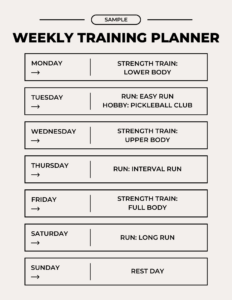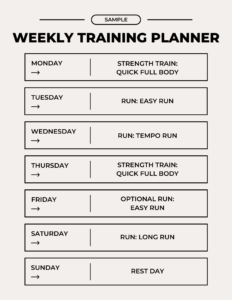How to Juggle Lifting & Running

by Rachel Pendakur, MA, CSCS,*D
Balancing running and resistance training can feel like quite the puzzle, especially if you’re trying to improve in both.
If you’ve ever trained for a race while keeping your numbers up in the gym, you may have experienced difficulty pursuing both endurance and strength. On the other hand, maybe you love lifting and want to improve your cardiovascular health without sacrificing your gains in the gym.
With the right approach, balancing hybrid training (lifting and running, in this case) is entirely possible. Let’s go over how smart programming and realistic goal-setting can set you up for success.
Why combine lifting and running?
Lifting and running offer unique benefits that go beyond performance in either area alone, making them a powerful combination for overall fitness and health.
The Benefits of Resistance Training
Resistance training (or strength training) is essential for building muscle, increasing strength, and enhancing movement efficiency. It improves coordination, increases force production, and strengthens connective tissues, reducing injury risk and enhancing our quality of life over the lifespan. Additionally, lifting helps preserve muscle mass, which is crucial for long-term health and body composition goals.
The Benefits of Cardiovascular Adaptations
Cardiovascular training builds endurance, allowing you to sustain effort for longer periods and recover more efficiently. It’s also crucial for supporting heart and lung function, stress management, and lowering the risk of chronic disease. While endurance exercise doesn’t contribute significantly to strength gains, it does improve work capacity, making fatigue more manageable during high-intensity strength sessions.
A Hybrid Approach for Broader Fitness Gains
Combining both running and resistance training creates a well-rounded foundation for fitness. Whether your goal is improving body composition, increasing energy levels, or simply feeling stronger and more capable in daily life, hybrid training offers a path to non-scale victories like improved mobility, better metabolic health, and enhanced performance.
Why One Alone Can’t Do It All
Strength and cardiovascular adaptations don’t perfectly overlap, meaning that one cannot be a complete substitute for the other, or provide the breadth of combined benefits. Lifting builds muscle, power, and structural adaptations, but doesn’t optimize heart and lung function the way endurance training does. Meanwhile, running enhances aerobic capacity but won’t maximize muscular strength or force production. To be truly well-rounded – both in performance and health-supporting behaviors – it’s a great idea to incorporate both.
Common challenges when juggling both
While the benefits of a hybrid training approach are clear, some real challenges come with trying to excel in both:
- Time Constraints: Fitting in multiple training sessions per week while managing work, family, and life commitments can feel overwhelming.
- Fatigue Management: Life gets busy, and without adequate recovery built into your plan, you may feel perpetually sore or exhausted.
- Competing Goals: Strength and endurance outcome goals don’t always complement each other. Training for a marathon may not be the time to sign up for a powerlifting competition.
How to successfully balance running and resistance training
1. Get Clear on Your Primary Goal
Trying to maximize both running and lifting at the same time can sometimes lead to stalled progress in both. Instead, determine your primary focus for each training block and prioritize that in the order you execute exercise modality and across your week:
- If your main goal is running performance (e.g., training for a marathon): Resistance training should support your endurance goals without interfering with your ability to recover from runs. If you’re tight on time, this is a great opportunity to focus on “minimum dose” lifting, aiming for at least 2 strength training sessions per week.
- If your main goal is strength and muscle growth: Keep running at a lower volume to maintain cardiovascular health while prioritizing progressive overload in the gym. Aiming for the American Heart Association’s recommendations of at least 150 minutes of moderate-intensity, or at least 75 minutes of vigorous exercise per week is a great goal to work up to.
- If your goal is general fitness and longevity: A balanced approach (2–3 strength sessions + 2–3 running sessions per week) is a fantastic split, aiming for at least the minimum effective dose of each to reap the benefits.
2. Consider Your Lifestyle Constraints
Your schedule matters. Instead of focusing only on training, or jumping right into what someone else is doing, consider the following:
- When do you have time to train without adding excess stress to your week?
- How much recovery time do you realistically need between sessions?
- How much energy do you have left for hobbies, social life, and rest?
- Do your goals match your current lifestyle priorities?
Training should enhance your life, not drain you completely.
3. Prioritize Recovery
Hybrid training without prioritizing recovery is a fast track to burnout. To optimize both running and resistance training:
- Periodize Intensity and Effort: Space out intense running and lifting sessions to support your recovery. Not all training bouts will impact your recovery in the same way. For example, you might feel ready to train on the same day as your weekly long run but wiped out after tempo or interval training. Conversely, you might know that lower body day takes all of your energy, so you make sure to schedule a rest day for the following day each week.
- Prioritize Sleep and Nutrition: Ample rest and sufficient calories – and protein – are crucial for supporting your body’s needs. Fuel your performance with adequate rest and nutrition to keep you training safely.
- Pay Attention to Your Body’s Cues: Don’t be afraid to scale back, adjust your plan, or give yourself a deload if your body needs it. Attending to biofeedback such as appetite, sleep quality, soreness, stress levels, etc. are great ways to stay proactive. Remember to take into account other weekly activities and hobbies that you might need to recover from.
Structuring Your Week: Sample Schedules
Your weekly plan will depend on your primary goal, schedule, and personal recovery needs. Here are a few examples:
1. You’re aiming to run 3x/week and lift 3x/week, but you need to make sure you have time for your weekly pickleball club – one of your favorite de-stressing activities.

2. Your work schedule is super demanding, so you’re shooting for lifting 2x/week and running 2x/week to maintain your cardio conditioning and strength.

3. Resistance training is not your favorite, but you know it ultimately supports your health and running performance as you prep for a half marathon. Because of this, you aim for 2 shorter, full-body sessions per week to cover your bases, and keep your mileage and enjoyment up with 3-4 runs/week.

Tips for Long-Term Success
Balancing running and resistance training isn’t about a perfect plan; it’s about taking an approach that adapts to your needs. Here’s how to stay consistent and avoid burnout:
- Listen to Your Body
Pay attention to fatigue, soreness, and energy levels. If workouts feel harder than usual, adjust your training or recovery. Progress comes from knowing when to push and when to ease up.
- Prioritize Gradual Progress
Avoid ramping up too quickly. Small, sustainable increases in mileage and weights will leave you feeling better over time instead of worse. You need time to progress both exercise modalities.
- Adapt Your Training to Your Season of Life
Your goals and schedule will shift. If you’re training for a race, strength can take a backseat; if life is hectic, maintenance may be best. Adjust as needed, and have fun with it!
- Track and Adjust
Monitor key performance indicators, like running pace, lifting numbers, energy levels, and don’t forget enjoyment. If something isn’t working, tweak your plan instead of forcing progress.
Conclusion
Finding the right balance takes time, but with smart adjustments and recovery, you can see progress in both. Stay flexible, focus on sustainable habits, and enjoy the process!




